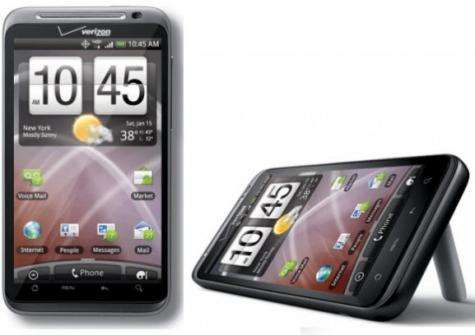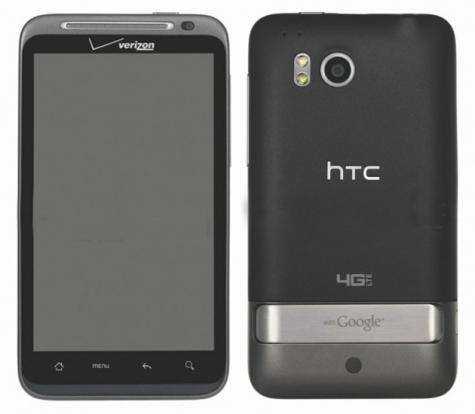HTC Thunderbolt smartphone underwhelms

The key feature of HTC's new Thunderbolt smartphone is its ability to tap into Verizon's speedy next generation data network. Unfortunately, there's little else to distinguish or recommend about the device.
The Thunderbolt is the latest in a string of super-sized smartphones running Google's Android operating system. With its 4.3-inch screen, touch-sensitive buttons below the screen, forward-facing camera above it and 8-megapixel camera and metallic kickstand in back, it's a close cousin of the Evo 4G, a phone that HTC released for Sprint nearly a year ago.
The chief difference between the two is that the Thunderbolt can access Verizon's 4G network rather than Sprint's.
Verizon turned on its LTE (or long-term evolution) network last fall. The network promises download speeds of up to 12 megabits per second, which is about 10 times faster than the top speeds offered on Verizon's older 3G data network.
The Thunderbolt is the first smartphone that can access that network, which until now could be accessed only by a PC using a USB modem.
In my tests, the Thunderbolt clocked impressive connection speeds. Outside my office, I saw download speeds as fast as 5 megabits per second and upload speeds as fast as 4 megabits a second. That kind of throughput was about 5 times faster than what I've seen on the Verizon version of Apple's iPhone, which is a 3G device.
And that speed does make a difference. It allows users to download Web pages, online games or digital songs much faster than they would be able to do otherwise.
Web surfing in particular was a joy on the Thunderbolt. Downloading pages is nearly instantaneous, similar to the experience one gets when connecting a smartphone to a fast landline network via a Wi-Fi hot spot.
I also enjoyed using the Thunderbolt's large screen and high-resolution camera. The screen made Web pages easy to read, and the camera took beautiful, vibrant shots that looked great on the Thunderbolt's display.
But there was a lot about the Thunderbolt that left me underwhelmed.
For instance, your ability to use it to access the Internet at ultra-fast speeds may be limited. Verizon is still building out its LTE network. It covers much of the San Francisco Bay Area and other major metropolitan areas, but those areas of coverage are like little islands; outside of them, you won't get LTE service.
Even inside those islands, coverage can be spotty. At my desk, for example, I could easily access Verizon's 3G service with the Thunderbolt but usually couldn't get its LTE network.
When you can connect to the LTE network, the speed comes with a big price: the battery life on the Thunderbolt is very short. You'll be lucky to get through a day of normal usage without needing a re-charge.
And except for downloading data, the Thunderbolt felt sluggish. Some of the latest Android smartphones, such as Motorola's Atrix, have been able to speed up their performance by running on so-called dual-core processors, which include two processing areas on a single computer chip.
Not the Thunderbolt, though. It runs on a single-core processor.

In my tests, the Thunderbolt often seemed to take a beat or two to switch applications or load up new ones. It often took several minutes at least to acquire satellite signals for its navigation program. And the video in games such as "Raging Thunder" were sometimes herky-jerky.
The Thunderbolt also runs an older version of the Android operating system. That's not a huge problem, given that its version includes one of the more important of the recent updates to Android, the ability to run Adobe's Flash software. But it does mean that if you are looking for the latest features in Android, you won't find them on the Thunderbolt.
The device also had some annoying tics. During my testing an obscure program running in the background repeatedly crashed, something I was alerted to by numerous error messages.
Additionally, I found the volume control button on the side of the device to be overly sensitive. I repeatedly turned off the volume unintentionally while just holding or rotating the Thunderbolt.
All that said, the Thunderbolt is not a bad device, especially if you're dying to have a Verizon LTE smartphone. But with plenty of other such devices slated to hit store shelves in coming months, at least some of which will feature newer, faster processors, the rest of us will be better off waiting.
HTC THUNDERBOLT SMARTPHONE:
-Troy's rating: 6.5 (Out of 10)
-Likes: Ability to connect to Verizon's speedy new data network; large, bright screen; high-resolution camera.
-Dislikes: Older processor; older version of Android operating system; short battery life; frequently sluggish performance; over-sensitive volume control.
-Specs: 1-Gh processor; 32-gigabyte SD card storage; 4.3-inch diagonal touch-screen display; 1.3-megapixel front-facing and 8-megapixel rear-facing cameras.
-Price: $250 with a two-year contract.
-Web: vzw.com or htc.com
More information: Troy Wolverton is a technology columnist for the San Jose Mercury News.
(c) 2011, San Jose Mercury News (San Jose, Calif.).
Distributed by McClatchy-Tribune Information Services.
















